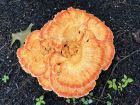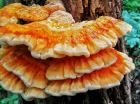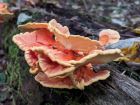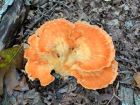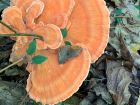Fruiting body usually forms a rosette of several to many fan-shaped to semicircular caps near the base of a tree, rarely appearing in a shelving array. Caps are pale to bright pinkish-orange with smooth to finely wrinkled, suede-like surfaces, often showing vague concentric bands that may fade with age or sun exposure. Margins are thick and often whitish. The undersurface is whitish, with small circular to angular pores and short tubes; it does not bruise when handled. Flesh is thick, soft and watery when young, becoming chalky and brittle with age; it remains white and does not change colour when sliced. A stem is usually absent or poorly defined and tough. Spore print white.
Microscopic Features: Spores measure 4–6 by 3–4 µm and are broadly ellipsoid, smooth and hyaline in KOH. They are inamyloid.
Laetiporus cincinnatus on the MushroomExpert.Com Web site.
Many mushrooms are poisonous, and some can be lethally toxic. Distinguishing between edible and poisonous mushrooms can be very challenging. Therefore, we strongly advise against consuming wild mushrooms. This website does not contain any information about the edibility or toxicity of mushrooms.
Although efforts have been made to ensure accuracy on this website, the information may contain errors and omissions. Therefore, all content provided is for educational and informational purposes only and should not be relied upon or used as a basis for consuming any plants or mushrooms.
External links are provided for reference only. We do not endorse or take responsibility for the content, advice, or products found on these sites or in any advertisements shown on this website.
